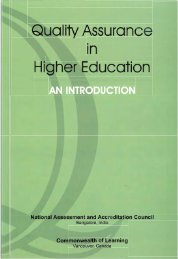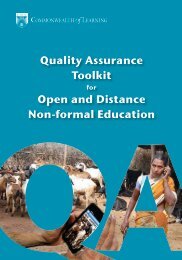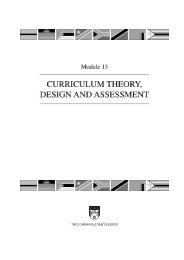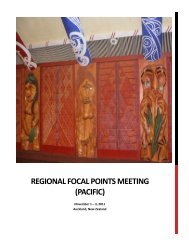Tech-MODE for Agricultural Education and Improved Livelihoods in ...
Tech-MODE for Agricultural Education and Improved Livelihoods in ...
Tech-MODE for Agricultural Education and Improved Livelihoods in ...
You also want an ePaper? Increase the reach of your titles
YUMPU automatically turns print PDFs into web optimized ePapers that Google loves.
STAKES AND CHALLENGES FOR TECH-<strong>MODE</strong> IN AGRICULTURAL EDUCATION IN CAMEROON<br />
farmers <strong>in</strong> the North-West Prov<strong>in</strong>ce” <strong>in</strong> 1987 sponsored by the International<br />
Development Research Centre (IDRC), Canada. The ODL model of IF <strong>in</strong>cludes<br />
Question <strong>and</strong> Answer Series <strong>in</strong> both pr<strong>in</strong>t <strong>and</strong> radio. No other technologies are<br />
used <strong>in</strong> this tra<strong>in</strong><strong>in</strong>g.<br />
Perhaps with the pass<strong>in</strong>g of time <strong>and</strong> chang<strong>in</strong>g circumstances, more NGOs might<br />
develop <strong>in</strong>terest <strong>and</strong> become <strong>in</strong>volved <strong>in</strong> open learn<strong>in</strong>g <strong>in</strong> agriculture <strong>and</strong> rural<br />
development <strong>in</strong> Cameroon <strong>in</strong> future. But the limit<strong>in</strong>g factor <strong>in</strong> these endeavours<br />
could be <strong>in</strong>experience, resources, tra<strong>in</strong>ers with ODL capabilities <strong>and</strong> environmental<br />
factors.<br />
8 Post-secondary agricultural education<br />
Formal agricultural education recognized <strong>and</strong> f<strong>in</strong>anced by government is offered <strong>in</strong><br />
Schools of Agriculture under the supervision of the M<strong>in</strong>istry of Agriculture <strong>and</strong><br />
Rural Development <strong>and</strong> Schools of Veter<strong>in</strong>ary Science under the M<strong>in</strong>istry of Livestock<br />
<strong>and</strong> Animal Industries. The location of such <strong>in</strong>stitutions is given <strong>in</strong> Figure 1.<br />
Schools of Agriculture<br />
Four Colleges of Agriculture (Bambili <strong>in</strong> the North West Prov<strong>in</strong>ce, Ebolowa <strong>in</strong> the<br />
South Prov<strong>in</strong>ce, Maroua <strong>in</strong> the Far North Prov<strong>in</strong>ce <strong>and</strong> Bertoua <strong>in</strong> the East Prov<strong>in</strong>ce)<br />
offer general agriculture tra<strong>in</strong><strong>in</strong>g <strong>for</strong> secondary school leavers. Admissions to these<br />
schools are by a competitive entrance exam<strong>in</strong>ation.<br />
Students who are holders of GCE OL certificates pursue studies lead<strong>in</strong>g to the<br />
award of a junior agricultural technical certificate after two years, while holders of<br />
GCE AL undergo studies lead<strong>in</strong>g to the senior technician diploma <strong>in</strong> agriculture<br />
after two years of successful studies. Approximately about 1500 c<strong>and</strong>idates nationwide<br />
write the entrance exam<strong>in</strong>ations each year, but only between 300 <strong>and</strong> 400 are<br />
accepted totally <strong>in</strong> the four Regional Colleges of Agriculture.<br />
Schools of Veter<strong>in</strong>ary Science<br />
The M<strong>in</strong>istry of Livestock <strong>and</strong> Animal Industries runs <strong>and</strong> controls three schools<br />
(one <strong>in</strong> Jakiri, North-West Prov<strong>in</strong>ce, a second <strong>in</strong> Foumban, West Prov<strong>in</strong>ce <strong>and</strong> the<br />
third <strong>in</strong> Maroua, Far North Prov<strong>in</strong>ce) <strong>for</strong> the tra<strong>in</strong><strong>in</strong>g of veter<strong>in</strong>ary nurses <strong>and</strong><br />
livestock technicians. The Foumban Centre places great emphasis on the tra<strong>in</strong><strong>in</strong>g<br />
of technicians <strong>in</strong> the fisheries. Approximately 4000 c<strong>and</strong>idates write the entrance<br />
exam<strong>in</strong>ations each year but only 1000 are admitted to the various schools.<br />
Wildlife <strong>and</strong> <strong>for</strong>estry schools<br />
The M<strong>in</strong>istry of Wildlife <strong>and</strong> Forestry runs <strong>and</strong> operates two schools: one <strong>in</strong><br />
Maroua (Far North) <strong>and</strong> the other <strong>in</strong> Mbalmayo (Centre Prov<strong>in</strong>ce). The school of<br />
wildlife <strong>in</strong> Maroua conducts tra<strong>in</strong><strong>in</strong>g <strong>in</strong> various areas of nature <strong>and</strong> wildlife<br />
conservation, while the school <strong>in</strong> Mbalmayo tra<strong>in</strong>s <strong>for</strong>est rangers. The total<br />
TECH-<strong>MODE</strong> FOR AGRICULTURAL EDUCATION AND IMPROVED LIVELIHOODS IN SUB-SAHARAN AFRICA: COUNTRY CASE STUDIES ■ 31









